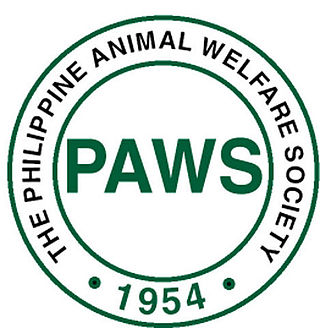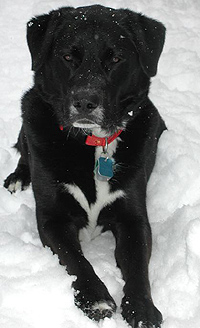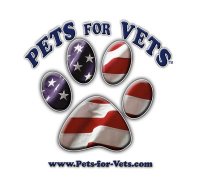Abandoned pets are companion animals that are either inadvertently or deliberately abandoned by their owners, by either dumping the animals on the streets, leaving them alone in a vacant property, or relinquishing them at an animal shelter.
Animal welfare laws in many states of the United States make it a crime to abandon a pet. [1] The UK passed the Abandonment of Animals Act 1960 which describes the offence of cruelty as "If any person being the owner or having charge or control of any animal shall without reasonable cause or excuse abandon it, whether permanently or not, in circumstances likely to cause the animal any unnecessary suffering, or cause or procure or, being the owner, permit it to be so abandoned." [2]
Often, when abandoned, pets are forced to fend for themselves and become stray or feral. Feral cats are said to outnumber feral dogs and can become challenging to handle and socialize enough to be re-introduced to a new human owner. In general, only some newly abandoned cats and very young feral kittens can be tamed. [3] There is a necessity to investigate interventions to prevent companion-animal relinquishment. [4]
Stray animals increase potential exposure to zoonotic diseases like rabies. Cat bites or scratches involving stray or feral animals are eight times more common than dog bites. [5]
Some pets relinquished to an animal shelter will be euthanized due to a lack of space or financial resources. [6] Millions of companion animals enter animal shelters every year in the United States. [7] However, the number of dogs and cats euthanized in US shelters declined from approximately 2.6 million in 2011 to 1.5 million in 2018. This decline can be partially explained by an increase in the percentage of animals adopted, and an increase in the number of stray animals successfully returned to their owners. [8] Studies show that the majority of people who relinquish an animal also report being emotionally attached to the dog. [9] It has been reported that when forced to abandon their animals in an evacuation, people suffer mental issues such as grief, depression, and post-traumatic stress disorder. Recognizing the importance of pets to their owners and their role in public health is an essential first step in improving a public health problem that has been seen repeatedly in the past and is unlikely to change in the future. [10]
Pet abandonment increased during the USA financial crisis of 2007–2008. [11] In early 2009, the ASPCA published advice for people facing foreclosure and the loss of their pets, recommending finding a foster or adoption situation for your pet, being aware of rental property rules for pets, and checking with animal shelters and animal rescue groups. [12]
The American Society for the Prevention of Cruelty to Animals (ASPCA) is a non-profit organization dedicated to preventing animal cruelty. Based in New York City since its inception in 1866, the organization's mission is "to provide effective means for the prevention of cruelty to animals throughout the United States."

Pet adoption is the process of transferring responsibility for a pet that was previously owned by another party. Common sources for adoptable pets are animal shelters, rescue groups, or other pet owners. Some organizations give adopters ownership of the pet, while others use a guardianship model wherein the organization retains some control over the animal's future use or care.

An animal shelter or pound is a place where stray, lost, abandoned or surrendered animals – mostly dogs and cats – are housed. The word "pound" has its origins in the animal pounds of agricultural communities, where stray livestock would be penned or impounded until they were claimed by their owners.

An animal control service or animal control agency is an entity charged with responding to requests for help with animals, including wild animals, dangerous animals, and animals in distress. An individual who works for such an entity was once known as a dog catcher, but is generally now called an animal control officer, and may be an employee or a contractor – commonly employed by a municipality, county, shire, or other subnational government area.

Trap–neuter–return (TNR), also known as trap–neuter–release, is a controversial method that attempts to manage populations of feral cats. The process involves live-trapping the cats, having them neutered, ear-tipped for identification, and, if possible, vaccinated, then releasing them back into the outdoors. If the location is deemed unsafe or otherwise inappropriate, the cats may be relocated to other appropriate areas. Ideally, friendly adults and kittens young enough to be easily socialized are retained and placed for adoption. Feral cats cannot be socialized, shun most human interaction and do not fare well in confinement, so they are not retained. Cats suffering from severe medical problems such as terminal, contagious, or untreatable illnesses or injuries are often euthanized.
Animal euthanasia is the act of killing an animal humanely, most commonly with injectable drugs. Reasons for euthanasia include incurable conditions or diseases, lack of resources to continue supporting the animal, or laboratory test procedures. Euthanasia methods are designed to cause minimal pain and distress. Euthanasia is distinct from animal slaughter and pest control.

A feral cat or a stray cat is an unowned domestic cat that lives outdoors and avoids human contact; it does not allow itself to be handled or touched, and usually remains hidden from humans. Feral cats may breed over dozens of generations and become an aggressive local apex predator in urban, savannah and bushland environments. Some feral cats may become more comfortable with people who regularly feed them, but even with long-term attempts at socialization, they usually remain aloof and are most active after dusk. Of the 700 million cats in the world, an estimated 480 million are feral.
The Anti-Cruelty Society is an animal welfare organization and animal shelter in the River North neighborhood of Chicago, Illinois. The Anti-Cruelty Society is a private, not-for-profit humane society that does not receive government assistance. It is one of the largest such organizations in the United States. The organization offers adoption, veterinarian, and training services.
In some countries there is an overpopulation of pets such as cats, dogs, and exotic animals. In the United States, six to eight million animals are brought to shelters each year, of which an estimated three to four million are subsequently euthanized, including 2.7 million considered healthy and adoptable. Euthanasia numbers have declined since the 1970s, when U.S. shelters euthanized an estimated 12 to 20 million animals. Most humane societies, animal shelters and rescue groups urge animal caregivers to have their animals spayed or neutered to prevent the births of unwanted and accidental litters that could contribute to this dynamic.
A no-kill shelter is an animal shelter that does not kill healthy or treatable animals based on time limits or capacity, reserving euthanasia for terminally ill animals, animals suffering poor quality of life, or those considered dangerous to public safety. A no-kill shelter uses many strategies to promote shelter animals; to expanding its resources using volunteers, housing and medical protocols; and to work actively to lower the number of homeless animals entering the shelter system. Up to ten percent of animals could be killed in a no-kill shelter and still be considered a no-kill shelter.

The Philippine Animal Welfare Society (PAWS) is a volunteer-based, non-government organization whose goal is to prevent animal cruelty through education, animal sheltering and advocacy, based in Quezon City, Philippines. It was founded in 1954 by Muriel Jay. PAWS believes that the creation of a more peaceful society starts with the widening of mankind's circle of compassion which includes animals, thereby envisions a nation that respects animals, practices responsible pet ownership and protects wildlife. The volunteer-based organization rehabilitates these animals in the hope of finding them new homes and a second chance at a good life. PAWS does not take in pets of other people, but only victims of cruelty or neglect where the animal offenders are charged with violation of the Animal Welfare Act in court.

Street dogs, commonly soi dogs in Thailand, are ownerless, free-ranging dogs. These dogs are sometimes rounded up and sold as meat in Vietnam and China. It is estimated that there are about 8.5 million dogs in Thailand, of which about 730,000 are abandoned by their owners. Bangkok alone is estimated to have from 100,000 to 300,000 street dogs. Few have been vaccinated against canine diseases.

Black dog syndrome or big black dog syndrome is a phenomenon in which black dogs are passed over for adoption in favor of lighter-colored animals. Black cats are similarly reported to be subject to the same phenomenon.
The National Animal Interest Alliance (NAIA) is a non-profit organization in the United States dedicated to promoting animal welfare and animal husbandry practices, strengthening the human-animal bond, and safeguarding the rights of responsible animal owners and professionals through research, public education and public policy. The NAIA mission is "to promote the welfare of animals."

Compassion and Responsibility for Animals (CARA) is a registered non-profit, non-government animal welfare organization in the Philippines. It was founded in 2000 by a group of animal lovers determined to help the plight of animals in the Philippines. The current president of CARA is Nancy Cu-Unjieng.

Street dogs, known in scientific literature as free-ranging urban dogs, are unconfined dogs that live in cities. They live virtually everywhere cities exist and the local human population allows, especially in the developing world. Street dogs may be stray dogs, pets which have strayed from or are abandoned by their owners, or may be feral animals that have never been owned. Street dogs may be stray purebreds, true mixed-breed dogs, or unbred landraces such as the Indian pariah dog. Street dog overpopulation can cause problems for the societies in which they live, so campaigns to spay and neuter them are sometimes implemented. They tend to differ from rural free-ranging dogs in their skill sets, socialization, and ecological effects.

Pets for Vets is a 501(c)(3) non-profit organization in the United States dedicated to providing a second chance to shelter dogs by rescuing, training, and matching them with American veterans who need a companion pet. It was founded in 2009 to help veterans who were suffering from combat stress and other emotional issues. Each companion dog is rescued in connection with local animal rescue groups.

A free-ranging dog is a dog that is not confined to a yard or house. Free-ranging dogs include street dogs, village dogs, stray dogs, feral dogs, etc., and may be owned or unowned. The global dog population is estimated to be 900 million, of which around 20% are regarded as owned pets and therefore restrained.

Cats are a popular pet in New Zealand. Cat ownership is occasionally raised as a controversial conservation issue due to the predation of endangered species, such as birds and lizards, by feral cats.

The Soi Dog Foundation is a nonprofit organisation for the welfare of stray dogs and cats. Its headquarters is in Phuket, Thailand, and it is a legally registered nonprofit organisation in Thailand, the US, Canada, Australia, France, UK, Switzerland, and the Netherlands. Its primary goal is to care for homeless and abused dogs in Thailand. It was established by British couple John and Gill Dalley with the help of Margot Homburg Park in Phuket in 2003.